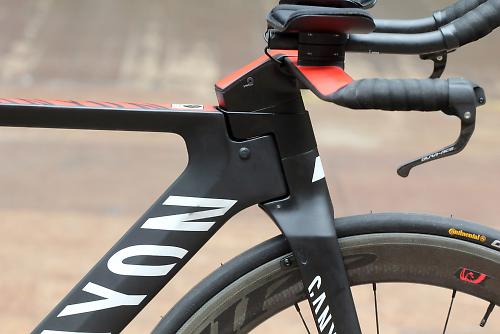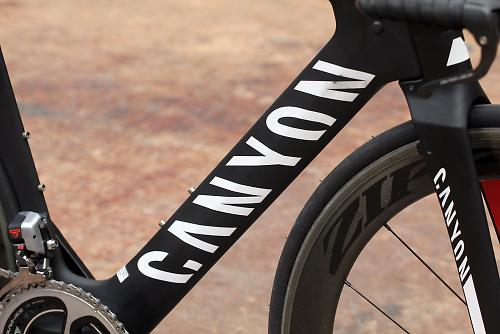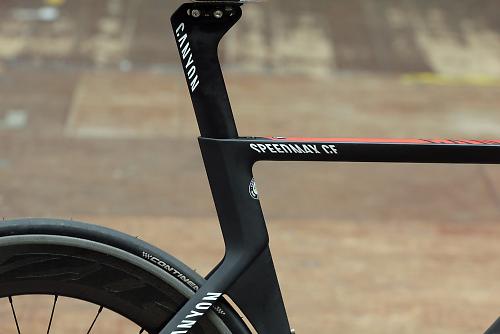- News
- Reviews
- Bikes
- Components
- Bar tape & grips
- Bottom brackets
- Brake & gear cables
- Brake & STI levers
- Brake pads & spares
- Brakes
- Cassettes & freewheels
- Chains
- Chainsets & chainrings
- Derailleurs - front
- Derailleurs - rear
- Forks
- Gear levers & shifters
- Groupsets
- Handlebars & extensions
- Headsets
- Hubs
- Inner tubes
- Pedals
- Quick releases & skewers
- Saddles
- Seatposts
- Stems
- Wheels
- Tyres
- Tubeless valves
- Accessories
- Accessories - misc
- Computer mounts
- Bags
- Bar ends
- Bike bags & cases
- Bottle cages
- Bottles
- Cameras
- Car racks
- Child seats
- Computers
- Glasses
- GPS units
- Helmets
- Lights - front
- Lights - rear
- Lights - sets
- Locks
- Mirrors
- Mudguards
- Racks
- Pumps & CO2 inflators
- Puncture kits
- Reflectives
- Smart watches
- Stands and racks
- Trailers
- Clothing
- Health, fitness and nutrition
- Tools and workshop
- Miscellaneous
- Buyers Guides
- Features
- Forum
- Recommends
- Podcast
Just in: Canyon Speedmax CF 9.0 SL time trial bike
We get a lot of head-turning bikes through the road.cc office, but few have turned as many heads as Canyon’s Speedmax CF 9.0 SL time trial bike. With angular frame profiles, barely any exposed cables and concealed brakes, it’s a strikingly futuristic-looking bike. Even compared to other time trial bikes, the Canyon really stands out.
It sure looks fast too. Just the other day, Alex Dowsett smashed the 10-mile national competition record on one with a time of 17:20mins, and the Speedmax was integral to Nairo Quintana’s victory in the 2014 Giro d’Italia (as was his strength and fitness, of course).

Canyon first introduced the Speedmax as a concept at Eurobike in 2011, and launched it properly the following year. The stiking looks have been generated as a result of Canyon’s development of the Trident tube profile using computational fluid dynamics (CFD) and validation in a wind tunnel. Simon Smart, the same chap who was involved in the design of the Scott Foil, Giant Trinity SL time trial bike and Enve rims, also lent his expertise to the design.

This Trident tube shape features a curved leading edge flowing into an angular, chopped-off tail. Canyon use it right across the frame in all the main frontal surface areas, so that’s the down tube, seat tube, seatpost, seatstays and fork legs.

Now is probably a good time to inject some of Canyon’s aero claims in, and they have a load of them. Their biggest claim is that the Trident is 10% less wind resistant than a NACA (National Advisory Committee for Aeronautics) drop-shaped profile. They also say the profile is less susceptible to crosswinds which should make it more stable in windy conditions, and that it is 20% stiffer, which should benefit handling.

Integration is big in aerodynamics. If you can conceal as much of the bike's mechanics and working parts inside the frame, you can reduce drag. The integration here is impressive, and is clearly one of the defining features of the design. Up front is the fork/handlebar/stem design with Canyon's own-design basebar sitting atop the fork in front of the truncated head tube.

Two cables exit the extensions and disppear into what is effectively the stem. The top plate can be removed and under it are hidden all the cables, including inline barrel adjusters for the brakes, and the Di2 control box. It’s a tight fit, but it is all squeezed inside. This all saves 8 watts, according to Canyon. The seatpost clamp is also integrated into the frame, and easily adjusted with a bolt just in front of the post.

Canyon developed their own centre-pull brake calipers. The front one is concealed behind the fork, and the rear brake virtually disappears down below the chainstays. For the front, brake blocks are adjusted through two ports in the legs, and higher up are on either side are tiny Allen bolts used to centre the brakes.
Adjustability is another area where the Canyon impresses. With the rider accounting for about 80% of the air resistance you encounter when cycling, getting a good aero fit, and one that is comfortable to ride in, is critical, so Canyon offer a stack of options. In fact, they claim thousands of variable cockpit options.

You can change extensions, base bar and stems to tailor the width and height to your requirements. This bike has a raised stem and flat base bar, but there is a flat stem, in different lengths, and a downswept base bar to choose if you want to get even lower.
There are three extensions too, these being the J-bend version. There are different pad widths too and the extensions can be mounted above or below the base bar. It's a bewildering choice. Seeing as I’m not getting any more flexible, I’m going to stick with this setup for now, but it’s good to know there are such options.

Canyon also offer two seatposts, one is UCI-legal and another steepens the seat angle to 78°, appealing to triathletes who aren't stifled by UCI rules. Our bike has the latter, just because that’s what it came with. Three sizes are available, this is the size small. It has a 499mm stack and 410mm reach, 70mm head tube, 539mm seat tube and 583mm top tube. The wheelbase is 989mm and the chainstays are short at 415mm. The head tube angle is 73.25°.

There are five models in the Speedmax CF range, starting from £3,440.87 and topping out with the £6,355.42 CF 9.0 LTD (the prices are so odd because they're converted from Euros and vary according to the exchange rate). This is the Speedmax CF 9.0 SL model, one down from the top, and it costs £5,999. It comes with a full Shimano Dura-Ace Di2 groupset (Canyon only offer Di2 builds with this bike, so it’s Dura-Ace or Ultegra).

It’s fully equipped with bar-end shifters on both the base bar and aero extensions providing easy gear changes, with carbon fibre brake levers. The battery is hidden inside the seatpost.

You need fast wheels on a time trial bike and a Zipp 404/808 Firecrest carbon clincher pairing should provide ample speed. They’re fitted with Continenta Grand Prix TT 23mm tyres. The saddle is a Fizik Arione K3. Weight is 8.15kg (17.96lb).
So there you go, a very fast looking bike indeed. We're going to hit the road on it now and enter some local time trials to see how it performs, full review in due course.
More at www.canyon.com
David worked on the road.cc tech team from 2012-2020. Previously he was editor of Bikemagic.com and before that staff writer at RCUK. He's a seasoned cyclist of all disciplines, from road to mountain biking, touring to cyclo-cross, he only wishes he had time to ride them all. He's mildly competitive, though he'll never admit it, and is a frequent road racer but is too lazy to do really well. He currently resides in the Cotswolds, and you can now find him over on his own YouTube channel David Arthur - Just Ride Bikes.
Latest Comments
- Sredlums 1 sec ago
It's sad when being very good at your job - any job - isn't enough to earn a decent living. It shouldn't be that way.
- eeney 11 min 1 sec ago
Bont double wide wearer here. Even Lake, for me, are too narrow in the toebox and midfoot, but Lake work for a lot of people....
- ktache 27 min 19 sec ago
I seem to recall saint Chris being more on recent BBC road cycling coverage rather than less.
- Rendel Harris 47 min 21 sec ago
So either it has to have the characteristics of a pogo stick or, more likely, that's a typo for "bunch sprint", which is equally nonsensical...
- chrisonabike 1 hour 39 min ago
I never heard of anyone having their leg sliced off / unexpectedly wiping out using a spoon brake, but discs...
- chrisonabike 1 hour 40 min ago
Meanwhile, in the Netherlands... (cycling to hospital, s''Hertogenbosch, Utrecht. Cycling to hospital and cycle parking, Assen)....
- Rendel Harris 2 hours 6 min ago
Sorry to say but your current trainer isn't going to be much use for online training in the way you describe, your virtual trainer will rely on not...
- andystow 2 hours 56 min ago
🎵 Sunshine on my shoulders makes me happy, sunshine in my eyes can make me crash. 🎵
- Jack Sexty 3 hours 21 min ago
The main featured link goes to the actual product - unfortunately the auto-generated widget is pulling in links to the old product right now, but...








































Add new comment
7 comments
Bought one, really happy
Any update on if/when there will be a full length review on this?
This really does look fast just stood still, although I much prefer it in the Movistar colours, the dark blue with green is a great colour combo on an angular bike like this.
If you ask me, it looks much better without the riser handlebar/stem, just the straight top tube/stem/bars combo like the older version had.
Go on, ask me.
I think that option is still available. As mentioned in the article, this is just set up with the angled stem.
Worth keeping an eye on the Euro as this could become even more of a bargain over the summer
Isn't that a fairing over the rear brake?